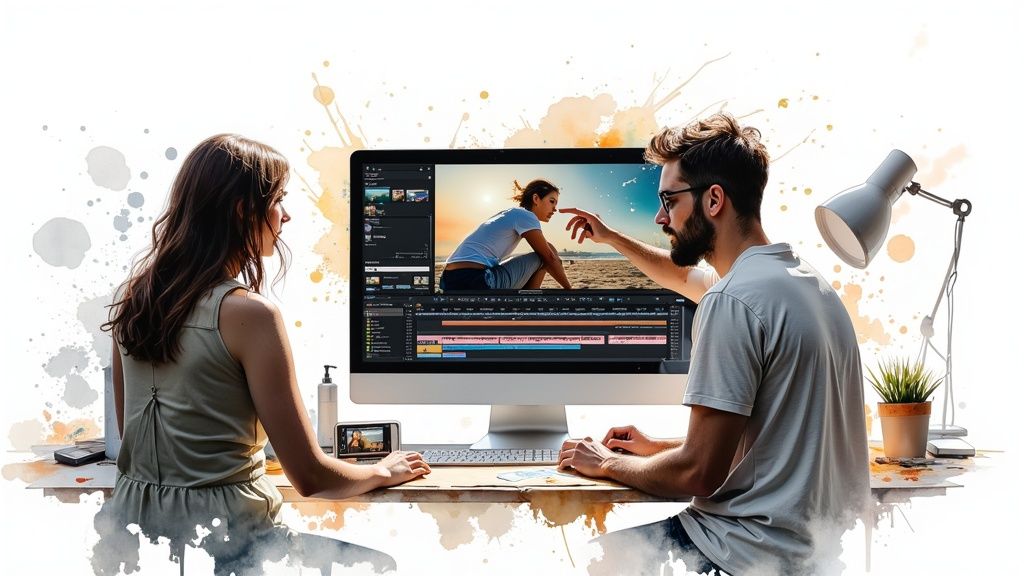Understanding The Business of Video Script Writing

Video content has become essential for connecting with audiences online, creating exciting opportunities for writers who can craft compelling scripts. From social media shorts to corporate videos, the demand keeps growing as more businesses invest in video marketing. For writers willing to develop their skills in this specialty, video scripting offers both creative fulfillment and income potential.
Why Video Script Writing is in High Demand
Businesses are shifting more of their marketing budgets to video because that's where their customers' attention is focused. More people now use video to research products and learn about services before making purchase decisions. This means skilled writers who understand how to write for video are becoming increasingly valuable. You might be interested in: How to create engaging content.
The numbers back this up - marketers spent a combined $21 billion on video production in 2022 alone. This significant investment reflects how central video has become to modern marketing strategies. For more details on the growing opportunities in this field, check out this overview of in-demand video script writing projects.
Earning Potential and Opportunities in Video Script Writing
Writers who specialize in video scripts can command impressive rates for their work. Experienced scriptwriters typically earn between $200 and $500 per scripted minute of video content. Many also boost their income by offering related services, like writing video descriptions and promotional copy. This combination of core scripting work and supplementary services makes video script writing financially rewarding for skilled writers.
The Skills That Set Successful Video Script Writers Apart
Great video scriptwriters combine solid writing fundamentals with specialized skills for the medium. They know how to write concisely and paint pictures with words that translate well to the screen. Understanding different video formats and platform requirements is also key - what works for YouTube might not work for TikTok or LinkedIn. The best writers in this field also excel at taking client feedback and collaborating with video production teams to bring scripts to life.
Building Your Professional Script Writing Toolkit
Writing great video scripts requires both skill and the right set of tools. A thoughtfully assembled script writing toolkit can make your writing process smoother and your output better. Let's look at the key tools and resources you'll need to craft compelling video scripts.
Essential Software for Script Writing
The right software can transform how you write and organize your scripts. Quality script writing tools typically include these core features:
- Formatting templates: Built-in templates for different script types (from YouTube videos to full screenplays)
- Collaboration features: Tools for team writing, commenting, and version tracking
- Visual organization: Digital cards and boards to map out scenes and story flow
Popular options include Final Draft, Celtx, and Fade In. Your choice should match your specific needs - for example, if you often work with others, pick software with strong collaboration tools.
Free vs. Premium Tools
While paid software offers advanced capabilities, several free options work well for those starting out. Tools like WriterDuet and Trelby provide solid basic features for formatting and organization. These free options let you develop your script writing skills before investing in premium software.
Making the Most of Automation
Smart automation tools can speed up parts of the script writing process. Some tools can turn blog posts into video scripts or convert recorded audio to text, saving you time on mechanical tasks. This frees you to focus on the creative aspects of writing while producing more scripts faster.
The market for these tools continues to grow rapidly. In 2024, the script writing software industry reached $178.8 million in value. Experts predict it will grow to $494.0 million by 2033 at a 12% yearly rate, driven by increasing demand for quality digital content and independent creators. Learn more about the expanding script writing software market.
Building Your Ideal Toolkit
Creating an effective toolkit means choosing tools that fit how you work and boost your creative output. Think about your budget, whether you need to collaborate with others, and your writing style when picking software. Start with basic tools and add more advanced ones as your needs grow. The best toolkit is one that helps you write engaging scripts that connect with viewers.
Mastering Essential Video Script Formats

Creating effective video scripts requires understanding the unique requirements of different formats. The type of video you're producing - whether it's a quick social media clip or an in-depth documentary - shapes how you need to write your script. Let's explore how to adapt your writing to make engaging content for any video format.
Understanding Different Video Formats
Video content comes in many forms, each designed to connect with viewers in specific ways. For instance, TikTok demands snappy, visually-driven scripts that grab attention in seconds, while YouTube tutorials need clear, detailed explanations that guide viewers step-by-step. Knowing these differences helps you write scripts that work best for each platform.
Case study videos often command higher rates because they require skilled storytelling to showcase real results and experiences. Meanwhile, social media videos must fit strict time limits while still delivering value. Each platform has its own best practices - for example, Instagram Stories work best with quick, punchy scripts that complement visual elements. You can learn more about professional scriptwriting trends in this industry report on script writing software.
Key Video Script Formats and Their Requirements
Here are the main types of video scripts you'll encounter:
- Explainer Videos: Focus on breaking down complex topics into simple, engaging content. Good explainer scripts use clear language and logical flow to help viewers understand new concepts.
- Social Media Videos: Need to capture attention fast - typically within the first 3 seconds. Instagram Stories are limited to 15 seconds, while IGTV allows up to 60 minutes. Your script should match the style and preferences of each platform's users.
- Testimonial Videos: Put real customer stories front and center. The script should feel natural and authentic, helping the person share their genuine experience.
- Documentary-Style Videos: Require detailed research and strong narrative structure. These longer scripts need to maintain interest while covering topics in depth.
Adapting Your Writing Style for Different Formats
The way you write needs to match your video format and target audience:
- Pacing: Short social videos need quick, energetic writing. Longer educational content works better with a measured pace that gives viewers time to absorb information.
- Tone: Match your writing to your audience - casual and fun for entertainment, professional for business content, or warm and approachable for educational videos.
- Visuals: Write with pictures in mind. Your words should work together with the visuals to tell a complete story.
Choosing the Right Format for Your Message
Pick your video format based on what you want to achieve and who you want to reach. Think about where your audience spends time online and how they prefer to consume content. For example, if you're explaining a complex product feature, a detailed tutorial might work better than a short social clip. When you match your format to your goals and audience, you create videos that truly connect and deliver results.
Crafting Hook-Driven Openings That Convert

You have just a few precious seconds to grab your viewer's attention before they scroll away. That's why your video script needs to start with a bang. Let's explore how to write powerful opening hooks that keep viewers glued to your content from the very first moment.
The Psychology of a Great Hook
People are naturally drawn to certain psychological triggers. When someone encounters something unexpected, mysterious, or personally relevant, they want to know more. For instance, asking a thought-provoking question activates the viewer's natural curiosity. Similarly, sharing a startling fact or making a bold claim sparks interest and compels viewers to stick around for the explanation.
Proven Frameworks for Hook-Driven Openings
Here are four tested approaches to crafting hooks that actually work:
- The Problem/Solution Hook: Identify a specific challenge your viewers face, then position your video as the answer they've been looking for
- The Question Hook: Open with an intriguing question that speaks directly to your viewer's interests or pain points
- The Story Hook: Share a brief, compelling personal story that connects emotionally to your main message
- The Surprise Hook: Lead with an unexpected fact or statement that makes viewers question what they thought they knew
Adapting Hooks to Different Video Types and Audiences
The perfect hook for one video might fall flat for another. Consider these key factors when crafting your opening:
- Platform Focus: What grabs attention on LinkedIn might not work on TikTok - know your platform's style
- Viewer Profile: Write for your specific audience's age, interests, and knowledge level
- Content Type: Match your hook's tone to your video's subject matter - serious topics need different approaches than fun ones
Testing and Optimizing Your Hooks for Maximum Impact
The best way to improve your hooks is through careful testing and measurement. Track metrics like viewer retention and engagement rates to see which openings perform best. Pay close attention to comments and feedback to understand what resonates with your audience. Use these insights to keep refining your approach. Remember: a strong opening is essential for creating video scripts that truly connect with viewers and achieve your goals.
Structuring Scripts for Maximum Engagement
Just like good architecture needs solid planning, an effective video script requires careful structuring to keep viewers watching from start to finish. The key elements include smart pacing, smooth transitions, and storytelling techniques that connect with your target audience.
The Importance of Pacing
Think of pacing like conducting a symphony - you need to vary the tempo to create the right mood. Quick cuts and dynamic visuals build energy and excitement, while slower, more deliberate sequences work better for explaining complex ideas or building emotional connections. The trick is matching your pacing to what you want viewers to feel and understand.
Transitioning Between Ideas
Clear transitions help viewers follow your story without getting lost. Simple phrases like "for instance," "in addition," and "however" create natural connections between different points. Visual transitions such as fades or wipes also signal when you're moving to a new topic. These act like road signs guiding viewers through your content.
Narrative Techniques for Engaging Storytelling
Good stories pull viewers in and make them care about your message. The classic three-act structure - setup, conflict, and resolution - provides a proven framework used in everything from short films to feature movies. You can also use techniques like cliffhangers between sections or personal stories to maintain interest throughout your video.
Adapting Structure for Different Video Lengths
Different video lengths need different approaches. A 30-second social clip might only need a quick hook and one clear point. Longer videos require more detailed planning with multiple sections and calls to action. Check out more tips here: How to master YouTube Shorts. It's like the difference between writing a tweet versus a full article.
Balancing Entertainment and Information
The best videos find the sweet spot between being fun to watch and delivering value. Pure entertainment can feel empty, while dry information alone gets boring. Mix engaging elements with useful content - like adding flavor to nutritious food. This keeps viewers interested while ensuring they learn something valuable.
Crafting Endings That Inspire Action
Strong endings bring everything together while motivating viewers to take the next step. Wrap up your key points, reinforce your main message, and give clear direction on what to do next - whether that's subscribing, visiting your website, or sharing the video. Think of it as giving viewers a clear path forward after watching.
Measuring Structural Effectiveness
Track how well your structure works by watching key metrics. The viewer retention rate shows how long people stick with your video - if they're dropping off early, you may need to adjust your pacing or transitions. Pay attention to comments too, as viewers often point out what worked and what didn't. Use this feedback to keep improving your scripts over time.
Platform-Specific Script Optimization

A great video script needs to be adapted for each platform where you'll share your content. Different platforms attract different audiences with their own viewing habits and preferences. Let's look at how to optimize your scripts for maximum impact across major video platforms.
Understanding Platform Nuances
Think of platform optimization like dressing appropriately for different occasions. You'd wear different outfits to a beach party versus a business meeting. The same principle applies to video content - what works well on YouTube might not connect with viewers on TikTok or LinkedIn. Each platform has specific expectations for video length, style, and content approach.
For instance, YouTube audiences often seek detailed, educational content, while TikTok users prefer quick, catchy clips. LinkedIn members respond best to professional, business-focused videos. Getting these differences right is key to connecting with your viewers. Read also: Future-Proofing Publisher Revenue.
Optimizing for YouTube
As the world's second-largest search engine, YouTube requires scripts that blend entertainment with solid information. Here's what to focus on:
- Keywords: Naturally include relevant search terms that help viewers find your content
- Clarity: Present information in a clear, structured way with supporting visuals
- Engagement: Add clear calls to action for likes, comments, and subscriptions
Tailoring Scripts for TikTok
TikTok's short-form format demands a different approach focused on immediate impact and shareability:
- Brevity: Hook viewers in the first few seconds with concise, punchy content
- Trends: Incorporate popular trends and challenges when relevant
- Visual Impact: Create strong visuals and add text overlays since many watch without sound
Crafting LinkedIn Scripts
LinkedIn's professional environment calls for a more polished approach:
- Professionalism: Use clear, business-appropriate language
- Value: Focus on practical insights and actionable tips
- Efficiency: Deliver your message clearly and respect viewers' time
Optimizing for Other Platforms
The principles of platform optimization apply across all video sharing sites. Always consider:
- Audience Profile: Who typically uses this platform?
- Content Style: What type of videos perform well here?
- Technical Needs: What are the ideal video lengths and formats?
By adapting your scripts to each platform's specific needs, you'll see better engagement and results. This focused approach helps ensure your message reaches and resonates with the right viewers.
Need help creating platform-optimized videos efficiently? Aeon is built specifically for publishers to turn text, video, or audio into engaging content with minimal effort. Check out how Aeon can help expand your video reach and improve your results.